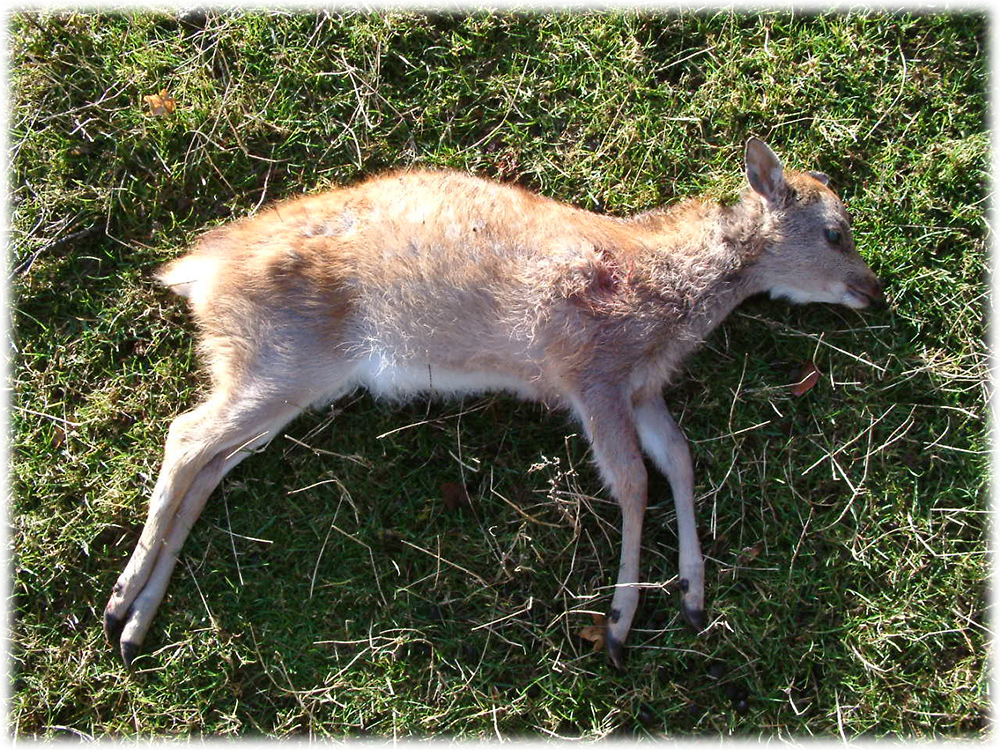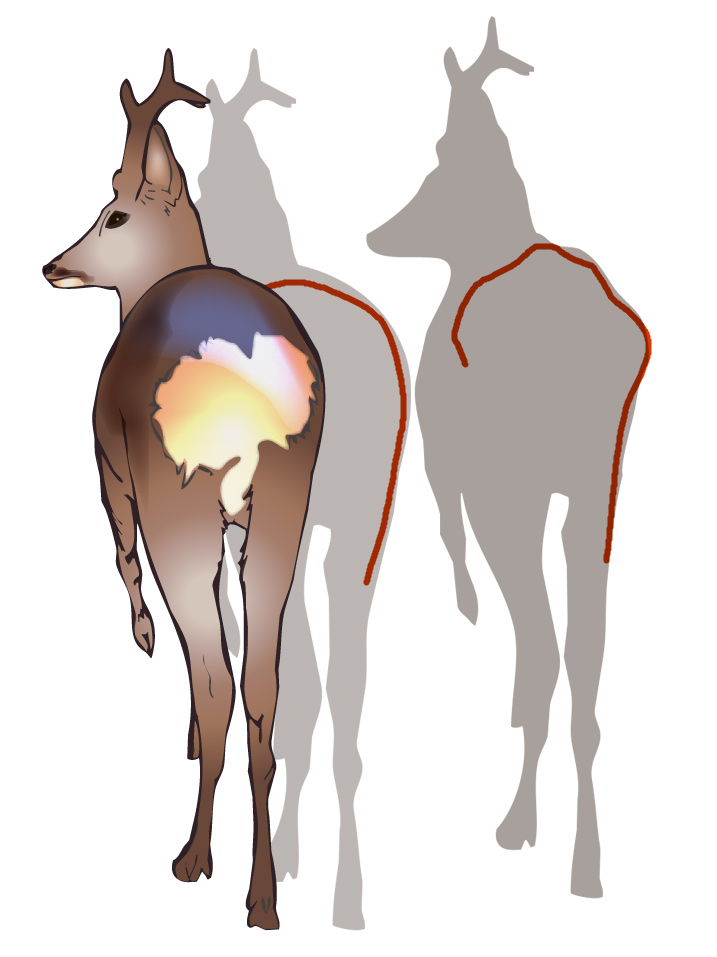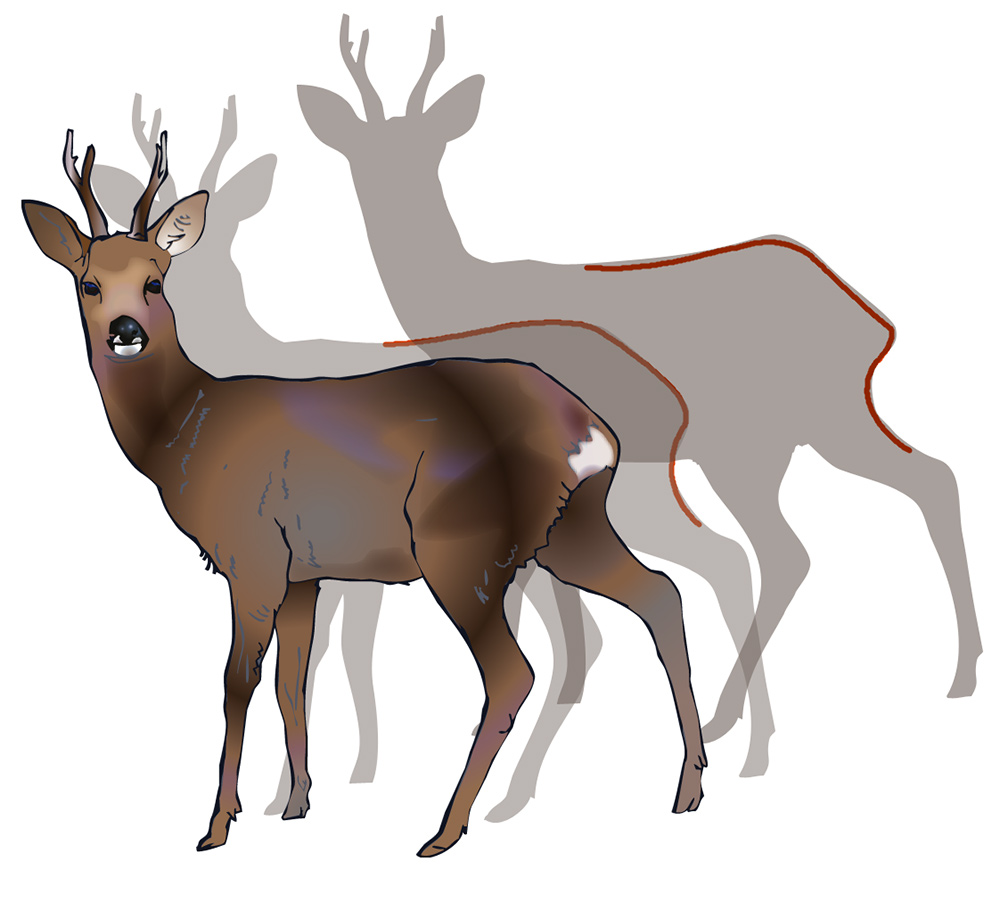
sika calf in poor condition. Note fluffy, ginger tinged coat
Introduction
Wild deer tend to be remarkably free of disease although they are susceptible to most of the accidents, diseases and parasites that affect other livestock. An ability to detect poor condition in both living and shot deer is an important skill in maintaining healthy wild deer populations. The aim of this guide is to highlight the factors to consider and signs to look out for when assessing the health of wild deer.
This guide links to the Species Ecology, Culling and Carcass preparation series of guides.
Normal condition
Deer in good condition will look, behave and move normally and are of normal size and carcass conformation. It is usual for deer to vary considerably in condition depending on the time of year – an animal which might be considered in good condition in late winter would be thought thin if seen in similar condition in August, while a lactating female might be perfectly healthy but look thin when compared to one which has no young. The circumstances and likelihood of recovering must be taken into consideration before deciding to cull. Deer that are in poor condition and not expected to improve should be culled.
Causes of poor condition
Deer may lose condition due to one or a number of causes:
| Causes of poor condition | |
|---|---|
| Normal/seasonal (from which animals usually recover) | Loss of weight due to lactation( females) Loss of weight post rut(especially Red and Fallow males) Loss of weight during winter - the young are usually getting bigger over winter but growth rates may be slow or they may lose weight in a harsh winter. Adults usually just maintain weight, but lose it in poor conditions, recovering rapidly in spring |
| Food restriction | Loss of weight due to lack of food (All ages) Animals may not recover weight in spring/summer, average adult body weights may fall over years) Lactation may cease early (dependent young) |
| Stress | Loss of weight due to disturbance on feeding and resting areas General harassment Entrapment Loss of guidance from dam(dependent young) |
| Injury | Deer/vehicle collisions Dog chasing/attacks Fence collisions Entanglement or entrapment (especially in fences or antlered males in twine/rope/netting) Shot injury Agricultural machinery (especially young in silage/hay fields) Other accidents Fighting (especially males) |
| Disease | Various symptoms and levels of severity (see Disease guide) |
| Age | Young deer – Prone to harsh weather , loss of lactation or guidance from dam Old age |

condition: (left) good and (right) poor

condition: (left) good and (right) poor
Assessing condition
Initial condition assessment usually takes place at a distance while the animal is alive, subsequently the carcass inspection may confirm the assessment or uncover other indicators. In general condition assessment in the field is:
- best based on a combination of features rather than relying on one character in isolation
- easier on open ground rather than in woodland where decisions may have to be based on a brief glimpse
- easiest in undisturbed groups of herding animals since it is possible to compare one with the other
- more accurate when using binoculars/telescope
| Signs of poor condition | |
|---|---|
| Behaviour | May not act normally for age and time of year Drooping posture Lethargic movement Inability to keep up with others Laying down frequently and reluctant to get up. Separates from herd or is rejected by others. Coughing/snorting frequently and persistently Cleaning/licking one area repeatedly. Limping or stumbling Shaking head repeatedly (may simply be due to “sweat” flies) Allows close human approach or contact rut (especially Red and Fallow males) Loss of weight during winter - the young are usually getting bigger over winter but growth rates may be slow or they may lose weight in a harsh winter. Adults usually just maintain weight, but lose it in poor conditions, recovering rapidly in spring |
| Appearance of live animal | Dull, “staring” coat with hair standing up. Ginger or grey look to coat. Missing hair (young roe may lose hair due to lice, especially in spring, they often recover). Take care to account for normal moult, especially in the spring Lack of flesh/fat over ribs, rump and pelvis Moult may be later than usual. Discharge or bleeding from eyes, ears, mouth or back end (roe are susceptible to scouring in the spring from which they often recover) Obvious injury, entanglement or entrapment Antler abnormality(often associated with direct damage not affecting general health, but may reflect more serious injury or disease) |
| Carcass | Poor coat quality, abnormal external appearance or smell Thin – ribs, spine, pelvis and haunches bony with poor musculature, individual limbs may be “wasted” Little or no internal fat especially around kidneys (take care to allow for normal seasonal variation) Carcass inspection reveals other signs of abnormality, injury, or disease (see carcass inspection guide). |
Further Info
Putman, R. (2005) Selection of animals for culling: age and condition. Project report RP41 for Deer Commission for Scotland.